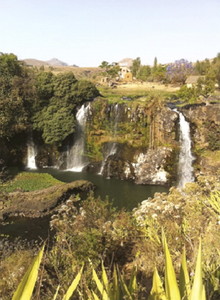A 44-year-old Spanish man presented with a 2-month history of fever after an 8-day trip to Madagascar. During his journey, he bathed once in the Lily waterfall near Ampefy, a village about 100 km west of Antananarivo (Figure 1). He did not recall any other freshwater exposures. Six days after the bath, he reported a 2-day febrile episode, with a maximum temperature of 40°C. Thereafter, he began experiencing malaise, low-grade fever, night sweats, and mild diarrhea. He denied any respiratory symptoms or urticaria. Physical examination was unremarkable. He had a total leukocyte count of 7,600 cells/μL (26% eosinophils). Chest x-ray and computed tomography scan showed multiple nodules in both lungs (Figures 2 and 3). Urine and stool tests for parasites and serology for Strongyloides spp., Toxocara spp., and Wuchereria spp. were negative. The result of a serologic enzyme-linked immunosorbent assay for Schistosoma spp. (NovaLisa, NovaTec Immundiagnostica GmbH, Dietzenbach, Germany) was strongly positive. With the suspicion of acute schistosomiasis the patient was treated with prednisone and two courses of praziquantel with full recovery.



Lily waterfall of Ampefy in Madagascar. Picture taken by the patient presumably the day of the infection.
Citation: The American Society of Tropical Medicine and Hygiene 86, 1; 10.4269/ajtmh.2012.11-0452



Chest radiograph showing ill-defined nodular opacities in both lungs.
Citation: The American Society of Tropical Medicine and Hygiene 86, 1; 10.4269/ajtmh.2012.11-0452



Computed tomography of the lung showing multiple round lesions of different sizes in both lungs.
Citation: The American Society of Tropical Medicine and Hygiene 86, 1; 10.4269/ajtmh.2012.11-0452
Acute schistosomiasis (also called Katayama fever or syndrome) is typically seen in nonimmune travelers. Diagnosis might be challenging as the three major clinical features (fever, rash, and respiratory symptoms) are non-specific and occur in combination in only a small percentage of patients.1 In addition, serum antibodies and egg excretion might be negative at the time of the clinical presentation.2 The chest radiograph may show different abnormalities, including multiple nodular lesions.1,3 Optimal treatment regimen for Katayama syndrome is not known. Praziquantel is considered the drug of choice for schistosomiasis but is relatively ineffective against the migrating larvae that are the cause of the acute symptoms. A course of praziquantel is required after 2–3 months of the exposure, when the infection is established and adult worms have developed. Concurrent administration of glucocorticoids is recommended to ameliorate symptoms related to the immunological reaction.2 Katayama syndrome should be considered in patients returning from endemic areas with fever, eosinophilia, and a nodular pulmonary pattern on imaging.
- 1.↑
Meltzer E, Artom G, Marva E, Assous MV, Rahav G, Schwartzt E, 2006. Schistosomiasis among travelers: new aspects of an old disease. Emerg Infect Dis 12: 1696–1700.
- 2.↑
Ross AG, Vickers D, Olds GR, Shah SM, McManus DP, 2007. Katayama syndrome. Lancet Infect Dis 7: 218–224.
- 3.↑
Schwartz E, Rozenman J, Perelman M, 2000. Pulmonary manifestations of early schistosome infection among nonimmune travelers. Am J Med 109: 718–722.











